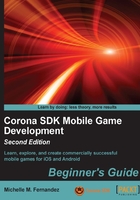
What this book covers
Chapter 1, Getting Started with Corona SDK, begins by teaching you how to install Corona SDK on both the Mac OS X and Windows operating systems. You will learn how to create your first program in just two lines of code. Lastly, we'll go through the process of building and loading an application to an iOS or Android device.
Chapter 2, Lua Crash Course and the Corona Framework, dives into the Lua programming language that is used to develop in Corona SDK. We'll go over the basics of variables, functions, and data structures in Lua. This chapter will also introduce how to implement a variety of display objects within the Corona framework.
Chapter 3, Building Our First Game – Breakout, discusses the first half of building your first game, Breakout. You'll learn how to structure game files in a Corona project and create game objects that will be displayed on screen.
Chapter 4, Game Controls, continues with the second half of building your first game, Breakout. We'll cover game object movement as well as collision detection between objects in the scene. You will also learn how to create a scoring system that will implement the win and lose conditions of the game.
Chapter 5, Animating Our Game, explains how to animate a game using sprite sheets. This chapter will go in-depth with managing motion and transitions while creating a new game framework.
Chapter 6, Playing Sounds and Music, provides information on how to apply sound effects and music to your applications. It is vital to include some type of audio to enhance the sensory experience of your game's development. You will learn how to incorporate audio through loading, executing, and looping techniques with the Corona Audio System.
Chapter 7, Physics – Falling Objects, covers how to implement the Box2D engine in Corona SDK using display objects. You will be able to customize body construction and work with the physical behavior of falling objects. In this chapter, we'll apply the uses of dynamic/static bodies and explain the purpose of post collisions.
Chapter 8, Operation Composer, discusses how to manage all your game scenes with Composer API. We'll also go into detail on menu design, such as creating a pause menu and main menu. In addition, you'll learn how to save high scores within your game.
Chapter 9, Handling Multiple Devices and Networking Your Apps, provides information about integrating your applications with social networks such as Twitter or Facebook. This will enable your app to reach a bigger audience globally.
Chapter 10, Optimizing, Testing, and Shipping Your Games, explains the application submission process for both iOS and Android devices. This chapter will guide you on how to set up a distribution provisioning profile for the Apple App Store and manage your app information in iTunes Connect. Android developers will learn how to sign their applications for publication so they can be submitted to the Google Play Store.
Chapter 11, Implementing In-App Purchases, covers monetization of your game by creating consumable, nonconsumable, or subscription purchases. You will apply for In-App Purchases in the Apple App Store using Corona's store module. We'll take a look at testing purchases on a device to check whether transactions have been applied using the Sandbox environment.
Appendix, Pop Quiz Answers, covers all the answers enlisted in the pop quiz sections of the book.